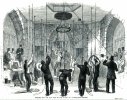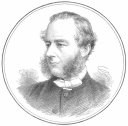Ringing through the Ages
Ringing is not just a modern activity. What thousands of ringers enjoy doing, and millions enjoy listening to, has fascinating history stretching back over centuries. If you would like to know more, read on ...
Did you know? :
In 2006, John Harrison, an All Saints ringer, recieved a Civic Award from the Mayor of Wokingham for services to the community through bellringing.
The social context
The world was a very different place when the roots of modern ringing first started to appear. The use of tower bells associated with Christian worship probably reached Britain in the 8th century, having spread from Italy at least 300 years earlier. As churches acquired more than one bell they would chime different combinations of bells to signal the different services - whether there would be a sermon, and so on. But the church building also played a big role in the secular life of communities. The bells happened to be in the church, but they were also the most practical means of sounding curfews, announcing fairs, etc.
On joyous occasions like weddings, they probably rang several bells at once, and swung them higher to make a louder sound. For this secular ringing, strong local men would be paid to assist, and so ringing came to be seen as a sport. People also rang for their own pleasure, and in towns with several churches they would pay the sexton to open the tower of whichever church’s bells they chose to ring.
The religious upheavals of the 16th & 17th centuries might have extinguished ringing, along with other church rituals, but its secular role helped to preserve it. Ringers had become largely independent of the church, and they formed their own organisations. The Ancient Society of College Youths was founded in 1637, and flourishes to this day as one of the premier ringing societies.
 Pleasure ringing must have been prolific because in some places there were orders to restrict it, for example at Preston in 1587, and it was even mentioned in a puritan act of parliament, which in 1643 forbade sport on the Lord's day, including 'ringing of bells for pleasure'. John Bunyan rang in his youth but later joined a sect that condemned ringing as sinful, and he feared that even if he even the pleasure of listening to it might incur divine wrath. All this hostility to ringing helped to keep what was s popular public activity quite distinct from the worship of the church, and it remained so for a long time.
Pleasure ringing must have been prolific because in some places there were orders to restrict it, for example at Preston in 1587, and it was even mentioned in a puritan act of parliament, which in 1643 forbade sport on the Lord's day, including 'ringing of bells for pleasure'. John Bunyan rang in his youth but later joined a sect that condemned ringing as sinful, and he feared that even if he even the pleasure of listening to it might incur divine wrath. All this hostility to ringing helped to keep what was s popular public activity quite distinct from the worship of the church, and it remained so for a long time.
The invention of the bell wheel
Changeringing couldn’t have developed without the bell wheel, which must have evolved at the same time. There are remains and drawings of the intermediate stages that suggest how it happened.
Originally bells would be swung by a simple lever (see below), but this does not allow the bell to be swung very high. Adding a sector to the lever, allows the rope to remain effective as the bell swings higher. Extending this to a three quarter wheel allows the bell to be swung almost to full circle, but at the low point of the rope’s travel, it is still not very effective. What was needed was something to make the rope start winding the other way round the wheel. Then there could be tension in the rope at both ends of the swing. This was first done by tying the rope to the wheel part way round with a 'garter' or 'fillet'. Eventually someone completed the wheel in its modern form, and to this day, the hole where the rope passes through the wheel to be tied onto the spokes is called the 'garter hole' or sometimes the 'fillet hole'.

Simple lever |

... down stroke |

... up stroke |
... |

Quarter wheel |

... down stroke |

... up stroke |

Three quarter wheel |

... down stroke |

... up stroke |
... |

With garter
second up stroke |

Full wheel
second up stroke |
|
Click here to see a bell wheel at All Saints .
The birth of change ringing
At some point, the idea of ringing in sequence took hold, so a typical performance would be to raise the bells, ring for a period and then lower them, probably ringing what we now call 'rounds' - sounding the bells in turn down the scale.
Change ringing, ie systematically varying the order of the sequence, probably began in the late 16th or early 17th century. The phrase 'ring the changes' entered the language, and appeared in a sermon in 1614. The names of early change sequences are similar to those used in the modern Devon call change tradition with names like 'the twenty' (probably 'twenty all over'). The maximum number of different orders of 5 bells is 120, and this is recorded around 1640. The system of 'plain changes' (where only one pair of bells swaps in the sequence at the same time) was still unlike modern change ringing where most bells swap places most of the time. See Explanation of change ringing .
 1668 saw the first book on ringing. Tintinnalogia was written by Richard Duckworth but Fabian Stedman (known as the 'father of changeringing’) has his name on the title page. It gave a huge boost to the spread of change ringing both within and outside the initial centres of London, Cambridge and Norwich. This and Stedman's Campanologia of 1677 provide the basis of modern changeringing, with methods described in terms of patterns of repetition, with one bell 'the Treble' providing a framework within which the others work. This is much easier to understand and learn than just writing out the numbers. See an example.
1668 saw the first book on ringing. Tintinnalogia was written by Richard Duckworth but Fabian Stedman (known as the 'father of changeringing’) has his name on the title page. It gave a huge boost to the spread of change ringing both within and outside the initial centres of London, Cambridge and Norwich. This and Stedman's Campanologia of 1677 provide the basis of modern changeringing, with methods described in terms of patterns of repetition, with one bell 'the Treble' providing a framework within which the others work. This is much easier to understand and learn than just writing out the numbers. See an example.
19th century reform & 20th century progress
 Social conditions changed drastically in the industrial revolution, and this affected ringers, whose behaviour was often seen as disorderly. By the mid 19th century, the church too was in decline, as were its buildings. With the 'Oxford Movement' of 1831, a group of young High Church men drove through reforms that affected most aspects of church life except the tower and ringers, who had long been more or less independent.
Social conditions changed drastically in the industrial revolution, and this affected ringers, whose behaviour was often seen as disorderly. By the mid 19th century, the church too was in decline, as were its buildings. With the 'Oxford Movement' of 1831, a group of young High Church men drove through reforms that affected most aspects of church life except the tower and ringers, who had long been more or less independent.
 Then a group of clerics led by Revd HT Ellacombe and Canon Woolmore Wigram started a complementary process that became known as 'Belfry Reform', to bring ringers more closely into the life of the church, and to improve their conduct. The reformers promoted change ringing, which they felt would improve the moral tone of ringers, and formed ringing societies so that ringers in different towers could help and support each other. Many of our modern territorial ringing societies date from the latter half of the 19th century, for example the Oxford Diocesan Guild of Church Bellringers, which was founded in 1881. The inaugural meeting was held at St Paul's, Wokingham, at the invitation of the Revd Dolben Paul and HC Sturgess, who had formed the Sonning Deanery Society the year before, which then became absorbed as the Sonning Deanery Branch of the newly formed Guild. The first master was the redoubtable Revd FE Robinson, who retired to Wokingham, where he died in 1910, and is buried at All Saints. See his story .
Then a group of clerics led by Revd HT Ellacombe and Canon Woolmore Wigram started a complementary process that became known as 'Belfry Reform', to bring ringers more closely into the life of the church, and to improve their conduct. The reformers promoted change ringing, which they felt would improve the moral tone of ringers, and formed ringing societies so that ringers in different towers could help and support each other. Many of our modern territorial ringing societies date from the latter half of the 19th century, for example the Oxford Diocesan Guild of Church Bellringers, which was founded in 1881. The inaugural meeting was held at St Paul's, Wokingham, at the invitation of the Revd Dolben Paul and HC Sturgess, who had formed the Sonning Deanery Society the year before, which then became absorbed as the Sonning Deanery Branch of the newly formed Guild. The first master was the redoubtable Revd FE Robinson, who retired to Wokingham, where he died in 1910, and is buried at All Saints. See his story .
With a resurgence of changeringing, the growing ringing societies felt the need to band together, and in 1891 they formed the Central Council of Church Bellringers, which now represents all major change ringing societies worldwide.
With the foundations in place, ringing prospered during the 20th century, despite the setbacks of two world wars, and it continues to push back the boundaries on all fronts, in method ringing, in our understanding of the science and technology of bells and bell hanging, and in the services and support provided to ringers, such as training. Ringers have exploited new technologies like computers to serve ringing in many ways.
 One measure of this progress is the number of peals rung each year. The first recorded true peal was rung on 2nd May 1715 at St Peter Mancroft, Norwich, and nearly a third of a million peals have been rung since then. Prior to Belfry Reform no more than a few dozen peals were rung each year but since then peal ringing has grown almost continually, apart from dips during the two world wars, to several thousand per year. (Click to enlarge the graph.)
One measure of this progress is the number of peals rung each year. The first recorded true peal was rung on 2nd May 1715 at St Peter Mancroft, Norwich, and nearly a third of a million peals have been rung since then. Prior to Belfry Reform no more than a few dozen peals were rung each year but since then peal ringing has grown almost continually, apart from dips during the two world wars, to several thousand per year. (Click to enlarge the graph.)
The rise and fall of bell founders

 There are records of about 170 bell founders operating in the UK during the last 750 years. Some foundries were short lived, but others operated for up to 600 years. As ringing developed, the number of bell founders increased, with rapid growth in the century when changeringing was evolving. At peak, there are nearly 60 bell founders operating in UK around 1700. After that, the number declines, probably driven by improving transport, first with the canals, then the railways and roads. Being able to supply bells economically over a larger area, would have increased competition in favour of larger, more efficient businesses. There was probably a reduction in total demand too, as more churches had bells, so a greater proportion of bells supplied would be for replacements or augmentations, rather than whole new rings. The graph on the left shows the number of foundries operating in any 25 year period from 1250 to the present. The graph on the right has a line for each foundry, and shows both the rate at which new businesses opened, and their varying longevity.
There are records of about 170 bell founders operating in the UK during the last 750 years. Some foundries were short lived, but others operated for up to 600 years. As ringing developed, the number of bell founders increased, with rapid growth in the century when changeringing was evolving. At peak, there are nearly 60 bell founders operating in UK around 1700. After that, the number declines, probably driven by improving transport, first with the canals, then the railways and roads. Being able to supply bells economically over a larger area, would have increased competition in favour of larger, more efficient businesses. There was probably a reduction in total demand too, as more churches had bells, so a greater proportion of bells supplied would be for replacements or augmentations, rather than whole new rings. The graph on the left shows the number of foundries operating in any 25 year period from 1250 to the present. The graph on the right has a line for each foundry, and shows both the rate at which new businesses opened, and their varying longevity.
See details of All Saints bells , the oldest of which were cast in 1703 and 1704.
Why in England?
Change ringing spread from England to other parts of the English speaking world, but what was so special about England that it only evolved here, and could only thrive here? And why did it not spread to continental Europe, with whom UK has exchanged trade, technology and social customs over the ages? We don't really know.
Forms of full circle ringing evolved in Northern Italy, but not changeringing. Carillons emerged in the Netherlands around the same time as change ringing in England, and they gradually spread to other European countries. Perhaps carillons filled the same public need for a 'joyful sound' as changeringing did in England, where carillons are relatively few. Catholic countries did not undergo the reformation that provided the spur to secularising English ringing, but what about the other protestant countries? England was at war with Holland, our nearest protestant neighbour at the critical time changeringing was developing, but what about the others? Maybe the booming English economy under Elizabeth was a critical factor, with the resultant wealth increasing the number of bells in many of eally know.
Since1977 four rings of bells have been hung for change ringing have been installed in mainland Europe – two in Holland and one each in France and Belgium,
 Pleasure ringing must have been prolific because in some places there were orders to restrict it, for example at Preston in 1587, and it was even mentioned in a puritan act of parliament, which in 1643 forbade sport on the Lord's day, including 'ringing of bells for pleasure'. John Bunyan rang in his youth but later joined a sect that condemned ringing as sinful, and he feared that even if he even the pleasure of listening to it might incur divine wrath. All this hostility to ringing helped to keep what was s popular public activity quite distinct from the worship of the church, and it remained so for a long time.
Pleasure ringing must have been prolific because in some places there were orders to restrict it, for example at Preston in 1587, and it was even mentioned in a puritan act of parliament, which in 1643 forbade sport on the Lord's day, including 'ringing of bells for pleasure'. John Bunyan rang in his youth but later joined a sect that condemned ringing as sinful, and he feared that even if he even the pleasure of listening to it might incur divine wrath. All this hostility to ringing helped to keep what was s popular public activity quite distinct from the worship of the church, and it remained so for a long time. 















